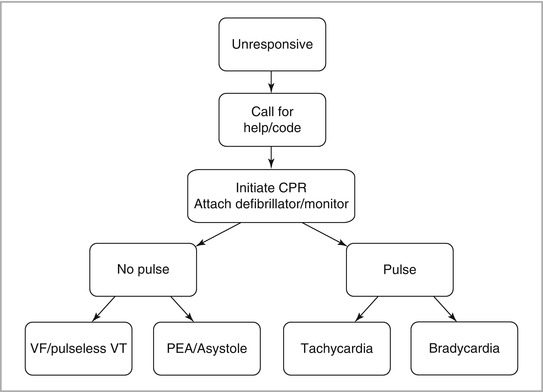and Hanna K. Gaggin2
(1)
Cardiology Division, Department of Medicine, Massachusetts General Hospital, Boston, MA, USA
(2)
Harvard Medical School Cardiology Division, Department of Medicine, Massachusetts General Hospital, Boston, MA, USA
Abstract
Successful resuscitation relies on a foundation of good Basic Life Support (BLS) and integration of Advanced Cardiac Life Support (ACLS) guidelines. Changes in ACLS from the American Heart Association (AHA) guidelines that all providers should be familiar with were introduced in 2010. Changes covering the basic elements of Circulation Airway and Breathing (CAB) have also been expanded to include post-cardiac arrest care and the Return Of Spontaneous Circulation (ROSC). Teamwork and closed-loop feedback communication solidify an integrated approach. This section summarizes the current adult recommendations highlighting the changes in guidelines.
Abbreviations
ABC
Airway Breathing, Circulation
ACLS
Advanced Cardiac Life Support
AED
Automated external defibrillator
AHA
American Heart Association
BLS
Basic Life Support
CAB
Circulation Airway and Breathing
CPR
Cardiopulmonary resuscitation
ETT
Endotracheal tube
IV
Intravenous
PEA
Pulseless electrical activity
PETCO2
Partial pressure of end-tidal carbon dioxide
ROSC
Return Of Spontaneous Circulation
VF
Ventricular fibrillation
VT
Ventricular tachycardia
Introduction
Successful resuscitation relies on a foundation of good Basic Life Support (BLS) and integration of Advanced Cardiac Life Support (ACLS) guidelines. Changes in ACLS from the American Heart Association (AHA) guidelines that all providers should be familiar with were introduced in 2010. Changes covering the basic elements of Circulation Airway and Breathing (CAB) have also been expanded to include post-cardiac arrest care and the Return Of Spontaneous Circulation (ROSC). Teamwork and closed-loop feedback communication solidify an integrated approach. This section summarizes the current adult recommendations highlighting the changes in guidelines.
Key Changes in the 2010 AHA Guidelines [1, 2]
Circulation, Airway, Breathing (CAB). This is the new sequence replacing the Airway, Breathing and Circulation (ABC). The priority is to decrease the time to first chest compression. Greatest survival rates happen with witnessed cardiac arrest, ventricular fibrillation (VF) and pulseless ventricular tachycardia (VT) [3].
Compression-only cardiopulmonary resuscitation (CPR) for the lay rescuer. If a sole lay rescuer is present or multiple lay rescuers are reluctant to perform mouth-to-mouth ventilation.
Adenosine was added for the diagnosis and treatment of stable undifferentiated regular and monomorphic wide complex tachycardia.
Atropine is no longer recommended in the use for pulseless electrical activity (PEA)/asystole.
Symptomatic unstable bradycardia. Intravenous (IV) chronotropic agents such as epinephrine and dopamine are recommended as they are equally effective as external pacing when atropine is ineffective.
Basic Life Support (BLS) = CAB D
(A)
Circulation
Chest compressions: at least 100/min and at least 2 inches in depth
30:2 compressions to ventilation ratio
(B)
Airway
Open airway: head-tilt, chin lift
Continuous quantitative waveform capnography (Class I recommendation) if available
If partial pressure of end-tidal carbon dioxide (PETCO2) <10 mmHg, confirm airway and monitor the endotracheal tube (ETT) placement if applicable
(C)
Breathing
8–10 breaths per minute
Avoid hyperventilation
(D)
Defibrillation
Automated external defibrillator (AED) as soon as possible
ACLS Algorithms
(A)
The unresponsive patient (Fig. 34-1)
 < div class='tao-gold-member'>
< div class='tao-gold-member'>





Only gold members can continue reading. Log In or Register to continue
Stay updated, free articles. Join our Telegram channel

Full access? Get Clinical Tree


